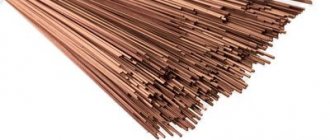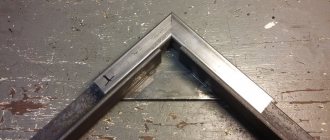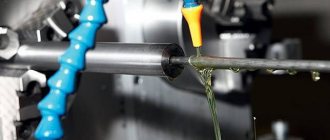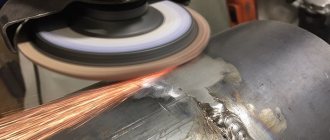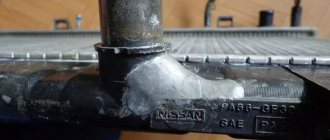Without reliable fixation of pipes during joining, it is impossible to obtain a reliable connection even if the welding work is carried out by a high-class worker. Manual installation and fixation in the desired position takes more time than applying a suture. Therefore, when installing pipelines, a welding centralizer is used, which simplifies and reduces the time required to complete the work.
Features and purpose
When loose pipes vibrate and move during connection, the seam becomes loose and can therefore crack even with minimal load. Therefore, the use of centralizers for welding pipes through which substances that are aggressive or hazardous to human health are pumped is mandatory. They can be used at temperatures from -45 to +45˚C. The accuracy of the alignment of the axes when assembling pipes for welding reduces the resistance coefficient. Therefore, the power of pumping units is reduced.
Depending on the design features, centralizers are used for joining diameters from 25 to 2000 mm. The basis of the design is the body, complemented by a stand or hook and a set of clamping elements. Their number can be changed depending on the diameter of the parts being connected. The equipment is attached to the pipeline on one or both sides of the joint and tightened with a tension mechanism, tightly connecting the ends.
Efficiency of centralizers and their types
The function of the centralizer is to ensure the necessary coincidence (not parallelism!) of the axes of the pipes before starting their welding. As a result, the dimensions of the welded zone are stable, so the process can be mechanized. In addition, using centralizers eliminates differences in the internal diameter at the joint. Consequently, pockets of possible turbulence in the flow of the working medium when it is pumped through a pipeline disappear, and the value of the drag coefficient also decreases. As a result, the specific power of the main pipeline pumping equipment also decreases.
The following requirements apply to the design of centralizers:
- Reliability of fixation of welded sections to each other.
- Accuracy of joining joints.
- Ease of installation and dismantling.
- Durability, regardless of the conditions of their use.
The classification of the most common types of centralizers can be made according to the following parameters:
- According to technological purpose. Centralizers are available for the internal and external diameters of pipes;
- By design. The connected sections of pipelines can be straight, or they can be located at some angle to each other;
- By the number of fixation points. For pipes of relatively small diameters, one-sided fixation is possible, while pipes with a diameter of over 400...600 mm must be fixed on both sides;
The use of centralizers slightly increases the cost of welding work, but this is the only drawback of the devices under consideration. In addition, the weight of most industrial models of centralizers can reach hundreds of kilograms, so their installation and operation require the use of lifting devices or mechanisms.
External centralizers for pipe welding
Their marking consists of the letters CN and a number indicating the maximum permissible diameter in mm. Common types include:
- Multi-link centralizers cope with diameters up to 2 m. They are assembled from elements connected by hinges. The links are tightened manually using a tension screw or hydraulic cylinder. Internal centralizers are more often used for joining large diameter pipes
- Arched varieties consist of two terminals with folding elements, which overlap each other during operation and are then pulled together by a manual or hydraulic mechanism. Designed to work with pipes with a diameter of up to 0.9 m. They are more durable than the previous version, since there are no hinges whose fingers wear out quickly. The number of arches is selected depending on the diameter of the pipes.
- Chain varieties are quickly brought into working position, therefore they are used for laying new and repairing emergency pipelines with a diameter of up to 1.4 m. However, the chain can only be tensioned manually.
- Eccentric devices are similar to arched devices, but the terminals are tightened with an eccentric clamp. When working, high skill is required from the worker, since an incorrectly fixed eccentric can become detached during welding. The disadvantages include rapid wear, which weakens the clamping force. The scope of application is limited to diameters of 0.4 - 0.5 m.
- Clamp-type centralizers are used to connect domestic pipelines with a small diameter. The advantages include compactness and manual clamping using a lever mechanism. The shape of clamps can be rectangular or arched.
- Spring types are indispensable for joining casing pipes underground when drilling wells. The household version is used for laying metal, polymer pipelines and with polyurethane foam.
Application
Centralizers have a wide range of applications. This is due to the fact that they are designed for welding pipes of various types and diameters. Because of this, they are used in the assembly of pipelines in the municipal and oil and gas industries. Centralizers are used to fix adjacent pipeline fragments during welding.
The relevance of these tools is determined by the great complexity of combining the connections of fragments of main pipelines by welding, especially of large diameters. This is due to sagging due to the low rigidity of the connected fragments. This must be avoided by ensuring alignment. Otherwise, the quality of the connection will significantly decrease. Moreover, it must be taken into account that coaxiality does not always mean parallelism.
Fixing the fragments ensures stable dimensions of the welding zone. In addition, if a centralizer is used for welding, differences are not formed on the inside of the joint, causing flow turbulence and increasing resistance during pipeline operation. That is, these defects worsen the hydraulic parameters, as a result of which more powerful pumping equipment is required.
Precise positioning ensures the same width of the weld around the circumference in the absence of undercuts, lack of fusion, or sagging, which increases strength. In addition, thanks to this, the use of mechanized welding is permissible.
Internal centralizers for pipe welding
The hydraulic drive of this equipment ensures internal centering of the pipes and eliminates deflections. They can appear under the influence of their own weight or from soil movements. Adjustment of the movement speed and clamping force is carried out using a DC motor mounted on a hydraulic drive. On pipelines with a diameter of up to 0.3 m, it is possible to use a manual drive.
When joining with an internal centralizer, it is inserted inside the pipe, and the second one is pushed in using a lifting mechanism. The ends are pressed using a hydraulic drive, and the joint is welded. A fan is used to prevent the pipes from becoming too hot during welding. The equipment is removed with a special rod, then inserted into the next joint. Movements are carried out until the completion of pipeline installation.
Internal centralizers are more often used for joining large diameter pipes
Other types
Along with the most popular and widely used equipment, there are less common and specific devices:
- arched;
- centralizer-clamp for pipes;
- spring ones, which are used for use with casing pipes in wells;
- mechanisms for polypropylene products.
The clamp centralizer is used to work with small pipes. This is the most popular variety, suitable for household purposes. These devices are affordable and have compact sizes. A pipe clamp is easier to use. The clamp can be rectangular (trapezoid-shaped) or round. The bottom element is most often flat.
Choosing the right centralizer
In order not to make a mistake with your choice, you need to take into account the recommendations of experts:
- For working with large-sized polyurethane foam pipes, internal centralizers are unrivaled.
- For pipes with a diameter exceeding 0.8 m, it is recommended to make connections using rigid arched or multi-link devices for outdoor installation. For smaller sizes, eccentric options will provide sufficient clamping force.
- If the pressure of the pumped substance exceeds 5 atm, a centralizer with a hydraulic clamp is selected.
- If there are increased requirements for the quality of the welded joint (for example, ellipse), a chain centralizer is selected.
- In terms of versatility, chain-type devices occupy first place.
Purchasing a centralizer is necessary if you often have to lay or repair pipelines. The high cost of additional equipment will pay for itself many times over by reducing repair costs and increasing the service life of water and heat supply communications. Especially if they are laid underground.
Advantages and disadvantages
The main advantages of centralizers include:
- improving the quality of welding due to precise positioning and fixation, which ensures a long service life;
- reduction of labor costs;
- mobility;
- low cost;
- multifunctionality, consisting in applicability for pipes of different types and sizes.
The main disadvantage of centralizers is considered to be a slight increase in the cost of work. In addition, many industrial models are characterized by large mass (up to hundreds of kg). Therefore, their use requires lifting devices. This also complicates and increases the cost of work.
You can also compare the external and internal views.
Tools of the first type are characterized by the following advantages:
- small dimensions and weight for most models;
- ease of use;
- Possibility of use under any conditions.
The main disadvantage is the fragmentary execution of work due to the need to constantly move the tool.
The main advantage of internal centralizers is to ensure continuous welding. However, these are large and heavy instruments with complex designs that require lifting equipment.
Some features of pipeline installation
When installing pipelines, it is best to weld the largest number of joints in a rotating position.
If the pipe wall thickness is 12 mm, welding is performed in three layers. The first layer creates penetration at the root of the seam and ensures good fusion of the edges. To perform local penetration, it is necessary that the deposited metal forms a narrow thread-like seam inside the pipe, 1-1.5 mm high, evenly distributed around the circumference.
To ensure penetration without sag or burr, the electrode is given a reciprocating motion, with a slight delay of the electrode above the molten pool of metal, slight transverse vibrations between the edges and the formation of a small hole at the top of the bevel angle of the edges. The hole is made by melting the base metal with an electric arc. The diameter of the hole is equal to the gap between the joints, or exceeds it by no more than 2 mm.
Additional
Models and prices
All centering devices available on the market for tools and devices are divided into two groups based on price:
- Domestic production. They are distinguished by a fairly reasonable price and ease of repair.
- Foreign production. They are distinguished by great ease of use and ergonomics, but have a significant drawback - high price. Among the manufacturers, it is worth highlighting the EU and the USA - their equipment is consistently high quality, but also consistently expensive. The price of products manufactured in Asian countries is slightly lower (with the exception of Japan - the cost of their products may exceed the price of EU products), but there is no guarantee of quality. It can vary greatly from one and the same manufacturer, even within the same batch.
The price of an external centering device ranges around 3-5 thousand rubles per piece (with a manual drive), if the external centralizer for pipes is equipped with a hydraulic drive and often an electric pump for it, the price increases 6-10 times and is about 100-150 thousand.
The cost of internal centering devices, regardless of the manufacturer, does not fall below 250-300 thousand. The presence of hydraulics in their design increases the cost by 35-40%.
When purchasing equipment such as a centering device, you need to focus not so much on the price, but on the expert opinion about the effectiveness of a particular device. Since the price is often high solely due to the advertising of the brand, and not its consumer qualities
Preparatory work
Before welding the pipe, it is necessary to prepare the metal in the joint area. The ends must be cut straight, otherwise it will be difficult to apply a reliable seam. The edges are chamfered so that the angle between them is 65 - 70˚. Surfaces at a distance of at least 3 cm from the ends are cleaned with a grinding machine or a metal brush until shiny inside and out. Areas that have changed color after treatment with a sander are removed. Burrs are removed with a file. The sharp edges of the edges are dulled to 2 mm, otherwise they will quickly melt. Then the surfaces are degreased with acetone.
The preparation of the electrodes is no less important. Before starting work, they are calcined in an oven at a temperature of 380 - 400˚C for two hours. For long-term storage, the electrodes are placed in a special case in which the temperature is maintained at 80˚C. A container for this purpose can be made independently from a polyurethane foam pipe. When long-term calcination is not possible, the electrodes are dried with a burner for one and a half minutes with a low flame. This method is prohibited by the rules, but in an emergency there is no choice. Since the coating of the electrodes dries quickly and picks up moisture again, you should not dry more than two pieces at the same time.
QUESTIONS ABOUT SELECTING A CENTRATOR
1. Pipe diameters?
2. Pipe wall thickness?
3. Steel grade with coefficient. strength (Mpa)?
4. Welding technology (manual arc welding, orbital welding, etc.)?
5. Should I use one centralizer for the entire range of pipe diameters or a separate centralizer for each diameter?
6. Required type of centralizer: external centralizer (chain, screw, clamp, eccentric), internal centralizer (manual, pneumatic, hydraulic)
7. Is it necessary to correct the ellipse of pipe joints before welding, types of deformation of the pipe edge (ellipseness, dents)?
Read also: Wood cutters for cutting locks
8. Is it necessary to weld pipes with bends (T-shaped, L-shaped)?
9. Other operating conditions (temperature, precipitation)?
Equipment for laying and turning of welded products
The stands do not provide tilting and rotation of products during operation, which makes it difficult to weld bulky and heavy components, therefore the welding installations include special equipment, namely: tilters, rotators, roller stands, manipulators and positioners.
Rotators are stationary devices in which the elements to be welded are not only secured, but also rotated around a horizontal or inclined axis in order to install them in a position convenient for welding, and sometimes to move them during welding. Rotators provide marching rotation of the product around a permanently located axis or around a number of axes lying in the same plane. The tilters have a manual or mechanical drive. Depending on the type of rotary device, there are roller, lantern, trunnion (center) and chain tilters.
Rotators are devices for rotating the welded product at working speed or at marching and working speed around an axis that does not change its position in space. There are rotators with a vertical, inclined or horizontal axis of rotation. Rotators with a vertical or inclined axis of rotation VV (vertical rotator) are sometimes called rotary by analogy with rotary lathes.
Welding rotator with a vertical axis of rotation: 1 – faceplate; 2 – bed with a rotation mechanism.
Roller stands or, otherwise, roller rotators or roller beds are designed to rotate and install the product in a position convenient for welding and to rotate the product at operating speed. The rotation of the product is carried out by driven, usually rubber-coated rollers coupled to the product. A significant advantage of roller stands is that the rotation speed of the product, regardless of its diameter, is equal to the peripheral rotation speed of the rollers. A conventional roller stand consists of a system of idle and driven roller supports mounted on a common foundation plate. Olive stands are used not only for welding, but also for assembly.
Manipulators are universal, usually stationary devices designed to rotate a product around an axis during the welding process at different angles of inclination of the rotation axis.
Universal welding manipulator: 1 – main frame; 2 – rotary frame; 3 – faceplate; 4 – faceplate rotation mechanism; 5 – mechanism for tilting the faceplate; 6 – support legs.
The manipulator consists of the following main components: a frame, a rotary table, drives for rotating and tilting the faceplate and a control unit. In most manipulators, all movements are mechanized. In some designs, the table can be tilted and raised manually. Some of them may not have a table lifting mechanism.
Positioners, unlike manipulators, are not designed for welding rotation of the product and serve only to install and rotate (turn) the product into a position convenient for welding. Positioners or installation manipulators are used both to secure the product and to install it in a position convenient for welding. All positioners are similar in design. They have two or three mutually perpendicular axes around which the faceplate with the product can be rotated or tilted.
Positioner setup diagrams
The positioner table rotates and tilts using a manual or electric drive; it has only a marching speed of movement. Positioners for products weighing more than 1.5 tons are usually electrically driven.
What defects may occur during welding?
The biggest defect in welding is considered to be lack of penetration. Welders who experience such flaws are not allowed to work on pipelines. Sloppy seams and their sagging, as well as other minor defects occur when welding technology is violated. To prevent them, work must be performed in compliance with the following conditions:
- welding is performed with a short arc at minimum current;
- detachment of the electrode is allowed only when replacing;
- careful selection of current;
- proper pipe preparation;
- carrying out work with calcined electrodes;
- the welding site must be protected from wind and precipitation;
- use of high-quality equipment and electrodes.
When mastering this type of welding, the main thing is to learn how to deposit the root of the weld. For training, you can take two metal plates 10 mm thick and grab them with a gap, not forgetting about preparing the joint. By fixing them at different angles, they practice welding skills in clearance horizontally, vertically, and on the ceiling.
Welding instructions
If you chose polyethylene pipes, you acted wisely, but now they still need to be installed correctly. Let's study
Basic rules
Regardless of which technology you choose - electrofusion or butt welding of polyethylene pipes, you must adhere to the following important principles:
- The connected elements must be compatible (both in composition and physical parameters).
- Butt welding of polyethylene pipes can only be done if the parts have the same diameter and equal wall thickness.
- The edges should be thoroughly cleaned and degreased.
- The ends of the structures that are not involved in the connection process must be closed with plugs in order to avoid exposure to cold air, which negatively affects the process.
- During work, it is necessary to minimize the impact of the external environment, namely:
- in hot weather, do not expose the connection area to sunlight;
- in windy weather, create a barrier to gusts of air;
- In cold weather, it is recommended to heat the work area.
- During welding and cooling of the structure, avoid mechanical impact on the system.
Now let’s look in detail at what the technology of butt welding polyethylene pipes is and using the electrofusion method.
Photo fragment of the electrofusion technique: attached heaters
Electrofusion connection
This type of welding, also called thermistor welding, is used for fastening elements of different wall thicknesses and diameters, as well as for installing non-pressure pipelines - drainage installations, gravity sewers, etc.
To connect using this technology, you will need special electric welded fittings. Now remember the order of work.
- Develop a system design.
- Calculate the required number of pipes and other parts.
- Make a purchase.
- Cut the structure into pieces of the length expected by the plan. Make sure that the cut is made smoothly and avoid molten material flowing into the system.
- Prepare and clean parts, including couplings. It would not be superfluous to degrease the surface of the elements using alcohol, applying it to a piece of rag.
- If the surface of the elements is oxidized, remove excess using a special scraper.
- Secure the elements in the positioner, remembering alignment.
- To prevent dust from entering, wrap the connection area with adhesive tape.
- Close the open ends of the structures with plugs.
- Apply voltage to the coupling terminals.
- Wait for the elements to warm up and stick together.
Thermistor welding of polyethylene pipes should be carried out only if the elements being connected are stationary. The structure should remain in the same position until the seam cools completely.
This is what a butt joint setup looks like
Butt welding
The technology and parameters for butt welding of polyethylene pipes are more interesting, since the elements are connected at the molecular level, forming a more durable seam. This method is used for installing elements with a diameter of 50 mm and a wall thickness of 5 mm.
With this method, the edges of the products are heated using a special heating device, and then melted and in this state are joined, forming one whole and a perfect seam.
The procedure for this type of welding up to point No. 7 is identical to the previous connection option (except that couplings are not required for the work).
Table for determining the heating and cooling time of welded elements
And then it differs and follows this “scenario”:
- Insert the ends of the elements into the apparatus so that the heating plate is between them;
- press the edges against the plate and do not change the pressure until the melting process;
- heat the elements, adhering to the standards (the table below for welding polyethylene pipes will help you with this);
- remove the slab and join the ends, applying uniform pressure to them;
- holding the knot, wait for the polyethylene to cool.
Types of seams
Regardless of what purpose the pipelines are welded for, they have welds that are formed using alternating electric current using a previously selected technology. Today, there are seams at an angle, butt and overlap. They all have their own individual methods and characteristics.
Butt joints are the most common, as they are characterized by the absence of metal deformation. In addition, they are minimally subjected to internal stress and are characterized by high strength with respect to dynamic and static loads. Butt welds are divided into single, used for pipes with a cross-section of up to 500 mm, and double, intended for pipes with a cross-section exceeding 600 mm.
Corner joints are considered butt joints. They are chosen when you need to fasten parts at an angle. Such seams are produced in two ways: without a bevel and with a beveled edge. Corner joints are not as strong as butt joints, but are still of good quality. Overlap seams are great for joining plastic pipes. They are rarely used when welding metal elements. This is explained by the fact that the connections are not very reliable.



